Stuart Weitzman School of Design
102 Meyerson Hall
210 South 34th Street
Philadelphia, PA 19104
Get the latest Weitzman news in your Inbox
Currently in Philadelphia, of the 1,146 acres of land along the central Delaware, only 8 acres are parkland. These 8 acres make up two neighborhood parks: Penn Treaty Park and Pulaski Park.
Philadelphians love their parks. Add a series of parks to the riverfront linked by a greenway and a water view and you have a special asset for the city that will generate millions to billions in new investment. Chicago built the 24.5-acre Millennium Park along its waterfront to spur economic growth. The city’s public investment of $270 million was originally expected to return $1.4 billion of private investment over ten years, but now the return is believed to total over $5 billion in job growth and tax revenue (27). Adjacent property owners are seeing an average bonus for units near the park of $100 per square foot and absorption rates 30 to 50 percent faster than those of comparable projects away from the park. In addition, the existence of Millennium Park played a role in attracting both Boeing and the BP subsidiary Innovence to locate their corporate headquarters in Chicago (28).
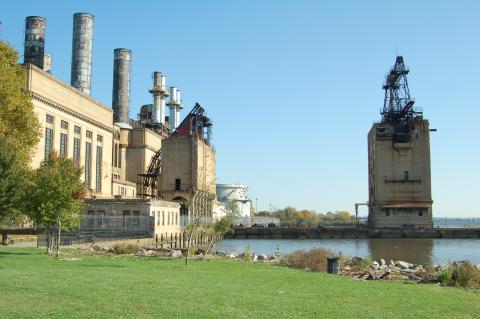
Penn Treaty Park, Philadelphia, PA
A park within a ten-minute walk or a quarter mile of every home or neighborhood is the civic vision’s goal for the central Delaware. To achieve this goal, publicly owned land will need to be transformed into larger destination parks. Private owners will be encouraged but not required to create small parks to serve their residents, customers and workers, as well as the public. The advantage of linking new development with a park is clear. For the owner, a single small park can raise property value by 30 percent, well beyond the costs of creating and maintaining the park (29). Nearby residential and commercial development will provide the people needed to keep parks lively, active and safe, day and night.
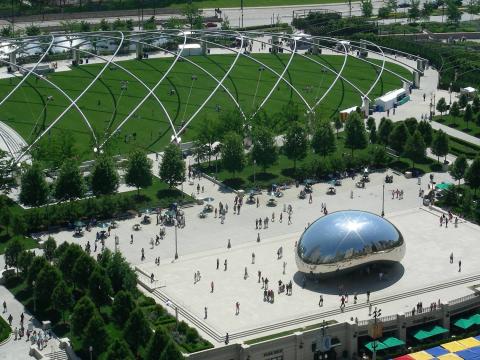
Millennium Park, which transformed 16.5 acres of underutilized land along Chicago's lakefront, is expected to yield $5 billion in job growth and tax revenue in its first ten years.
To reach this goal, we must accomplish the following:
Create destination parks on public land at the Festival Pier, former incinerator site and Penn’s Landing. On the few publicly owned parcels within the central Delaware, we can provide parks that will serve the entire city and region. Two adjacent pieces of public land, located at Spring Garden Street, Festival Pier and the former incinerator site, currently serve as concert locations during warm months. By taking better advantage of these sites—adding attractive gathering areas, events and activities—we could make them lively, year-round destinations for residents and tourists. On Penn’s Landing, from Walnut to Market Streets along the river, an extraordinary opportunity exists to replace cement with grass and create a great lawn where Philadelphians can play games, sunbathe or read. Other activities could be offered, including water features such as splash pads that provide a playground for kids, interactive public art and attractive viewing areas for watching ships. As the popularity of these new destination parks grows, Philadelphia could extend the riverfront and add performance space by using a floating concert and movie barge, as cities across the country have done.
Open publicly controlled piers, such as Pier 11 beneath the Benjamin Franklin Bridge, for public use and provide unique waterfront-recreation spaces. New York City’s Hudson River Park converted one former shipping pier into a dog run, another into a golf driving range and some piers into playgrounds for children. The piers, like all potential park sites, must be tested for environmental contamination, and environmental remediation must be completed if needed. Parks and green spaces built on former industrial sites must be cleaned to the same level required for residential properties, with virtually all contamination removed.
Improve the existing 8 acres of parkland. Fishtown’s Penn Treaty Park and Port Richmond’s Pulaski Park provide the riverfront’s only parkland, yet both need significant improvements. Although the Fairmount Park Commission controls Penn Treaty and the Philadelphia Department of Recreation controls Pulaski Park, maintenance has been left largely to volunteer friends-of-park organizations. Penn Treaty will have an opportunity to create a master plan for improvements and upgrades through a grant from the Department of Conservation and Natural Resources (DCNR). It is hoped that Pulaski Park will have a similar opportunity in the next year.
Expand boating and fishing opportunities along the central Delaware by building a public marina and fishing piers and encouraging private boat-rental operations along the river. Today, motor boating is a popular river activity, yet there are no active public marinas on the Philadelphia side of the Delaware and just a few private marinas. Activating the public marina in the boat basin of Penn’s Landing would provide a much-needed place to launch and dock boats. Motorboat, kayak and canoe rentals would give many households the chance to enjoy the river (30). Less experienced kayakers and canoeists could be driven to a safe, calm launching point without currents or wakes from large ships and could be returned to centrally located Penn’s Landing after their trips. Well-maintained, safe fishing piers and a cleaner river’s edge will also expand the small number of locations from which residents can enjoy fishing.
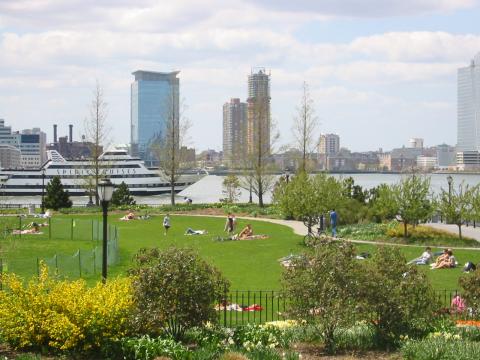
Battery Park City, New York
Short-Term Actions
- Improve two existing parks.
- Create destination parks on publicly owned land, such as Pier 11 and Penn’s Landing. Encourage riverfront owners to dedicate land for public parks as a part of their open-space requirement.
- Determine the condition and feasibility of converting each publicly owned pier into publicly accessible open space.
- Test potential destination-park sites for environmental contamination.
- Purchase priority parcels for parks or recreational activities as they become available, with support from DCNR and private foundations.
- Define the best uses for vacant and underutilized public spaces and approach owners about improving the land. (For example, cities have placed skate parks under freeway ramps and dog runs on piers.) Land under the reconstructed Girard Avenue Interchange provides an important opportunity for the creation of a new green space and a path to the river.
Short-Term Park Opportunities: Recommended Locations
- Transform Pier 11 beneath the Benjamin Franklin Bridge into a high-quality public space.
- Create a destination park at the foot of Spring Garden Street on the publicly owned Festival Pier/incinerator site. Issue a Request for Proposals for a landscape architect to design the park space in 2008–2009.
- Create a park under I-95 at the Girard Avenue Interchange that would offer a pedestrian route under I-95. This is just one example of how we can take advantage of the imminent need to replace or rebuild aging roads and sewer infrastructure to implement innovative improvements. This is currently budgeted as a part of the Pennsylvania Department of Transportation’s plan for the rebuild of the Girard Interchange.
- Preserve and restore the Wood Street Steps.
Longer-Term Actions
- Build diverse, attractive parks on available land.
- Establish an endowment for their maintenance or encourage opportunities for consistent revenue streams (e.g., concessions). While it is fairly easy to obtain new dollars to support a new park or program, it is far more difficult to obtain funding for their maintenance. As a result, many waterfront agencies have fundraised for a maintenance endowment during their early years, when excitement about the new riverfront is at its highest.
- Create new opportunities for fishing, boating and other water recreation.
Longer-Term Park Opportunities: Recommended Locations
- Create a great lawn at Penn’s Landing in the area between Walnut and Market Streets. By transforming the cement gathering spaces of Penn’s Landing into a great lawn, we will create a destination park. At the foot of Dock Street, improve the boat basin to encourage people to come to the river (31).
- Develop Pier 53 South as a new park at the end of Washington Avenue. Penn’s Landing Corporation controls the pier. The civic vision extends Washington Avenue to the river and moves it a bit to the south (see section five) to open up more space.
- Create Ore Pier Park. At the end of Cumberland Street, where the Ore Pier stands, another small park is planned. Conrail owns the pier but has left the site unused, without plans to restore working rail lines to the site.
- Plan and create an open space at the end of the Lehigh Viaduct.
- Explore possible open space and development options for the site of the former West Shipyard (on Delaware Ave. between Vine and Callowhill) that honor the archaeological and historical significance of the site.
Civic Actions: What Philadelphians Can Do
- Define the park activities and amenities that your neighborhood needs most.
- Identify highest-priority improvements for Pulaski Park and Penn Treaty Park and actively engage in the planning process for these parks.
- Inform residents that density on the riverfront makes sense for the river when it is paired with trails, greenways and parks.
- If you live in a river neighborhood, help create a new park in your neighborhood by helping to identify a park site and determining the type of park needed.
- If you make use of a river park, organize volunteers to ensure its regular maintenance.
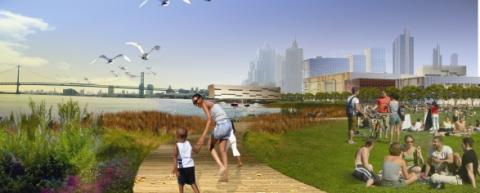
Benefits and Impact
Economic: Parks raise values of nearby properties and attract new investment, employers and residents.
Environmental: Parks help manage stormwater, keep air clean and connect city residents to nature.
Community: Parks improve health by providing places to play and exercise and bring residents together.
Impact on City Budget: The cost to create a recreational park is approximately $1.75 million per acre (32). This figure does not include funding for environmental remediation if the soil is contaminated. Ongoing costs, based on a study of New York City waterfront public-space maintenance, are $55,000 per acre for maintenance and landscaping and $18,000 per acre for security.
Other Cities Have Done It - We Can Too
Cities are building parks to attract economic development, and the strategy is working. Chicago transformed 16.5 acres of commuter rail lines, a surface parking lot and another 8 acres of shabby parkland that fronted historic Michigan Avenue into Millennium Park, attracting billions of dollars of new investment. San Jose and Louisville built waterfront parks and attracted about four private investment dollars for every public dollar invested. Parks are good business.
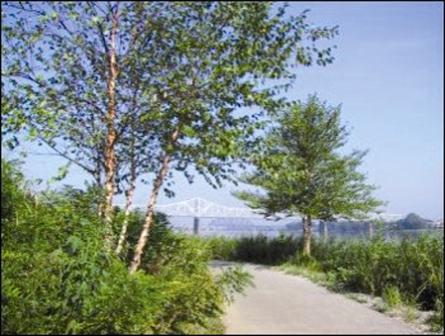
Louisville, KY
Funding Resources
- Funding has already been approved for the improvement of Penn Treaty Park: The Pennsylvania Department of Conservation and Natural Resources has granted funding to create a master plan and to implement improvements.
- Take Me to the River Grant Program (DVRPC): A $1 million grant pool is available for projects to improve riverfront areas.
- Trump Tower and Penn Treaty Tower riparian lease agreement:Under the state’s riparian land lease, Trump and Penn Treaty Towers must dedicate 50 cents for every square foot of building space to implementing the Civic Vision for the Central Delaware.
- Grants from private local and national foundations.
- Keystone Community Grant Program (DCNR) gives grants to governments to support the planning, design and development of greenways and parks. Planning grants are typically $50,000 or less. Land acquisition and construction grants range from $150,000 to $200,000.
- Tax Increment Financing: As noted, creating a TIF district is an excellent way to generate funds for creating and maintaining parks.
- Legislative Initiative Grants, or WAMs (Walking Around Money), are state discretionary funds available to create or improve parks.
- Four percent of gross casino revenues are specified by the Commonwealth’s Gaming Act to offset increased city operating costs for managing the impact of the casinos on transportation, the police, and the health, safety and social welfare of areas surrounding the casinos.
